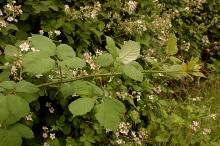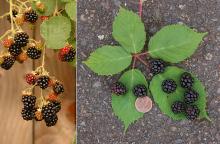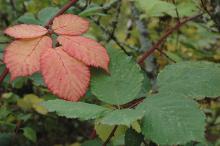Rubus armeniacus
Common name:
Himalayan Blackberry
Armenian Blackberry
Pronunciation:
RUB-us ar-men-ee-AH-kus
Family:
Rosaceae
Genus:
Synonyms:
Rubus discolor
Rubus procerus
Type:
Broadleaf
Native to (or naturalized in) Oregon:
Yes
- Broadleaf evergreen to (barely) semi-evergreen shrub, to 10 ft (3 m) high, erect branches, then arching, trailing, may root where branch nodes contact the soil, sprawling to form large, dense, impenetrable thickets. Branches (canes) sharply angular, glabrous, dark purplish, densely covered with stout, bowed "thorns" (actually prickles since they arise from epidermal cells). Canes can grow to a length of over 20 ft (6 m) in a single season. Leaves alternate, palmately compound, 3-5 obovate to elliptic leaflets, each 4-8 cm long, margins irregularly serrate, dark green, glabrous, somewhat glossy above, gray-green below with soft pubescence. Branches or stems are biennial, in the first year they are sterile, called primocanes, producing leaves but no flowers. In the second year lateral branches, called floricanes, arise from axils of primocanes and produce both leaves and flowers. Flowers are white to reddish, 2.5 cm wide, in clusters (racemes) wider than long. Fruit about 2.5 cm long, an aggregate of drupelets, glossy black, edible (actually delicious!).
- Hardy to USDA Zone 6 Native to much western Europe, and apparently there is no evidence that it is native of the Himalayan region.
- Caution: Himalayan Blackberry has become naturalized in the northeastern U.S., from Delaware to Virginia, but especially in the Pacific Northwest, from southern British Columbia eastward to Idaho and south to northern California. It is a very robust, rapidly spreading, invasive plant, and a common saying in Oregon's Willamette Valley is, "if we all left the valley, in 3 years Himalayan Blackberry would prevent us from getting back in"!
- Once known as Rubus discolor; dicolor: two-colored, a reference to the difference in color between the upper (green) and lower (gray-green) leaf surface.
- Rubus armeniacus: (this is now the preferred name for this plant); armeniacus: of Armenia, western Asia












